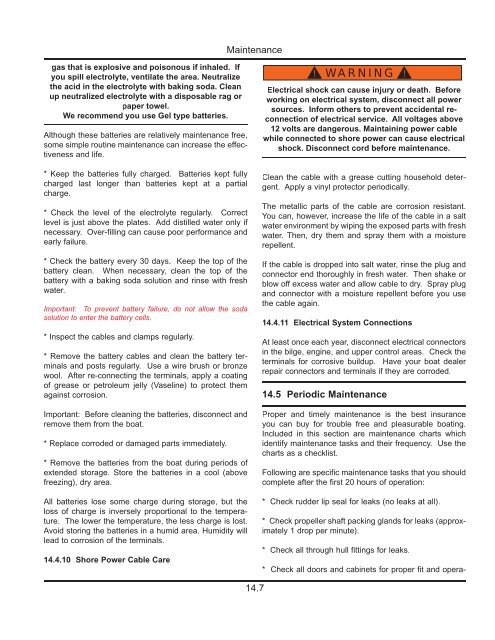36e Operator's Manual 2011.pdf - Marlow-Hunter, LLC
36e Operator's Manual 2011.pdf - Marlow-Hunter, LLC
36e Operator's Manual 2011.pdf - Marlow-Hunter, LLC
You also want an ePaper? Increase the reach of your titles
YUMPU automatically turns print PDFs into web optimized ePapers that Google loves.
Maintenance<br />
gas that is explosive and poisonous if inhaled. If<br />
you spill electrolyte, ventilate the area. Neutralize<br />
the acid in the electrolyte with baking soda. Clean<br />
up neutralized electrolyte with a disposable rag or<br />
paper towel.<br />
We recommend you use Gel type batteries.<br />
Although these batteries are relatively maintenance free,<br />
some simple routine maintenance can increase the effectiveness<br />
and life.<br />
* Keep the batteries fully charged. Batteries kept fully<br />
charged last longer than batteries kept at a partial<br />
charge.<br />
* Check the level of the electrolyte regularly. Correct<br />
level is just above the plates. Add distilled water only if<br />
necessary. Over-filling can cause poor performance and<br />
early failure.<br />
* Check the battery every 30 days. Keep the top of the<br />
battery clean. When necessary, clean the top of the<br />
battery with a baking soda solution and rinse with fresh<br />
water.<br />
Important: To prevent battery failure, do not allow the soda<br />
solution to enter the battery cells.<br />
* Inspect the cables and clamps regularly.<br />
* Remove the battery cables and clean the battery terminals<br />
and posts regularly. Use a wire brush or bronze<br />
wool. After re-connecting the terminals, apply a coating<br />
of grease or petroleum jelly (Vaseline) to protect them<br />
against corrosion.<br />
Important: Before cleaning the batteries, disconnect and<br />
remove them from the boat.<br />
* Replace corroded or damaged parts immediately.<br />
* Remove the batteries from the boat during periods of<br />
extended storage. Store the batteries in a cool (above<br />
freezing), dry area.<br />
All batteries lose some charge during storage, but the<br />
loss of charge is inversely proportional to the temperature.<br />
The lower the temperature, the less charge is lost.<br />
Avoid storing the batteries in a humid area. Humidity will<br />
lead to corrosion of the terminals.<br />
14.4.10 Shore Power Cable Care<br />
! WARNING !<br />
Electrical shock can cause injury or death. Before<br />
working on electrical system, disconnect all power<br />
sources. Inform others to prevent accidental reconnection<br />
of electrical service. All voltages above<br />
12 volts are dangerous. Maintaining power cable<br />
while connected to shore power can cause electrical<br />
shock. Disconnect cord before maintenance.<br />
Clean the cable with a grease cutting household detergent.<br />
Apply a vinyl protector periodically.<br />
The metallic parts of the cable are corrosion resistant.<br />
You can, however, increase the life of the cable in a salt<br />
water environment by wiping the exposed parts with fresh<br />
water. Then, dry them and spray them with a moisture<br />
repellent.<br />
If the cable is dropped into salt water, rinse the plug and<br />
connector end thoroughly in fresh water. Then shake or<br />
blow off excess water and allow cable to dry. Spray plug<br />
and connector with a moisture repellent before you use<br />
the cable again.<br />
14.4.11 Electrical System Connections<br />
At least once each year, disconnect electrical connectors<br />
in the bilge, engine, and upper control areas. Check the<br />
terminals for corrosive buildup. Have your boat dealer<br />
repair connectors and terminals if they are corroded.<br />
14.5 Periodic Maintenance<br />
Proper and timely maintenance is the best insurance<br />
you can buy for trouble free and pleasurable boating.<br />
Included in this section are maintenance charts which<br />
identify maintenance tasks and their frequency. Use the<br />
charts as a checklist.<br />
Following are specific maintenance tasks that you should<br />
complete after the first 20 hours of operation:<br />
* Check rudder lip seal for leaks (no leaks at all).<br />
* Check propeller shaft packing glands for leaks (approximately<br />
1 drop per minute).<br />
* Check all through hull fittings for leaks.<br />
* Check all doors and cabinets for proper fit and opera-<br />
14.7

















